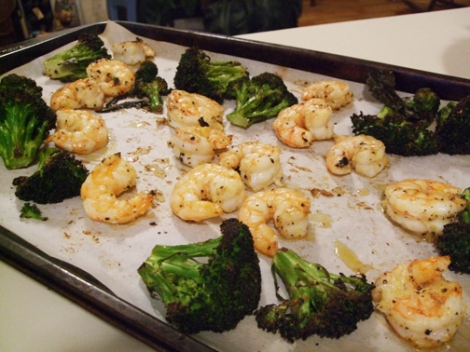The BP oil spill has been spewing oil into the Gulf of Mexico for about a month now, with no end in sight. As oil and chemicals drift towards the Louisiana coast, it’s easy to imagine the destruction being inflicted on these fishing grounds and the people who make their livings from them. This article from the New York Times addresses the issues straight-on, explaining how the majority of our domestic seafood comes from either Louisiana or Alaska, and how this spill will likely cause seafood shortages from the Gulf. It makes me wonder, between E-coli laced meat and toxic seafood, what will be left for us to eat?
One of the many reasons why I feel so sad about the BP situation is because in the past few years, I had recently renewed my love for shrimp. It all started with my first trip to Disneyworld as a child—whenever I think about it, I don’t remember the exhilarating curves and dips of Space Mountain or the sentimental sweetness of the It’s a Small World ride. No, my most vivid memory is of sitting at a white-clothed table with my parents and younger sister in front of a tall, narrow glass filled with my first shrimp cocktail. After my initial bites of those cold boiled shrimp dipped in their deliciously zesty tarter sauce, I couldn’t get enough, and I think I had a shrimp cocktail every night for the rest of that week. Mickey Mouse and Goofy just couldn’t compete.
But something changed in my early twenties, and for a long while I couldn’t stand the sight of shrimp. It had something to do with the texture, and I didn’t touch them for years. But in an effort to partake of their health benefits, I started eating and enjoying them again a few years ago. Their mild flavor works well in a variety of recipes, from Italian to Asian and everything else in between.
Currently my favorite shrimp dish is this recipe from the New York Times, published over a year ago. From the moment it appeared, these roasted, lemon-infused shrimp and smoky, cumin- and coriander-accented broccoli took the blogging world by storm, and with good reason. Served with brown or white rice, they form an easy and healthy meal, packed with a unique and addictive combination of flavors. I’ve been making it at least once a month for the past year, and I haven’t tired of it yet.
Jim and I recently tried a Thai-inspired recipe from Food & Wine as well, an intriguing mix of grilled shrimp, garlic, cilantro, shallots, red pepper, and soba noodles, mixed with various Asian seasonings. Jim loved the spicy combination of flavors with the buckwheat noodles, and I expect this recipe to enter our regular dinner rotation as well. We slurped up every bite in one sitting.
I don’t mean to minimize the oil spill in the Gulf with petty talk about my favorite shrimp recipes; there are so many huge ramifications of this catastrophic event that it depresses me just to read about them. But talking about the impact of this spill on my daily life in Brooklyn, miles away from where it is actually happening, reminds me that I’m really not so distant from it at all. These disasters, both natural and man-made, impact us all in one way or another. Shrimp dinners are just the beginning.









 Subscribe to the Choke
Subscribe to the Choke 
